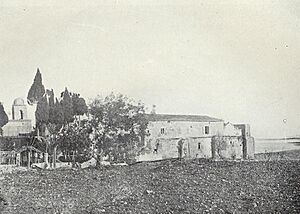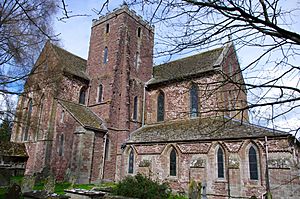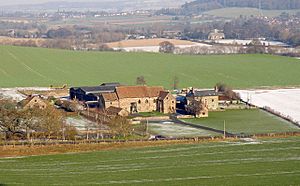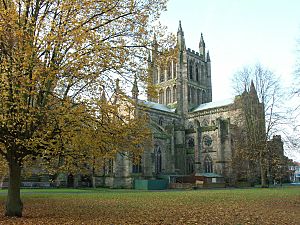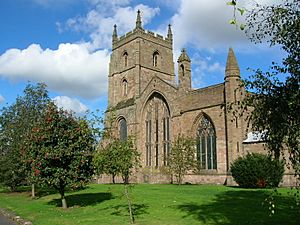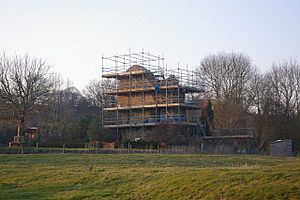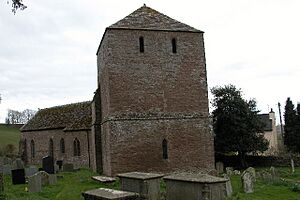List of monastic houses in Herefordshire facts for kids
This article explores the monastic houses in Herefordshire, England. These special places were once homes for groups of people who dedicated their lives to religious service. They lived together under strict rules. Monastic houses include abbeys, priories, and preceptories.
Contents
What are Monastic Houses?
Monastic houses were buildings where monks, nuns, or friars lived. They followed specific religious rules. These communities played a big role in medieval society. They were centers for learning, prayer, and helping the poor.
- Monks and Nuns lived in abbeys or priories. They usually stayed within their community.
- Friars were different. They often traveled to preach and help people in towns.
- Preceptories were like military bases for groups like the Knights Templar and Knights Hospitaller. These were warrior monks who protected pilgrims.
Many of these houses were closed down in the 1500s. This event is known as the Dissolution of the Monasteries.
Monastic Houses in Herefordshire
Herefordshire was home to many different types of monastic houses. Some were very old, dating back to Saxon times. Others were built much later. Let's look at some of the most important ones.
Abbeys and Priories
These were the most common types of monastic houses. An abbey was a large, independent community led by an abbot or abbess. A priory was usually smaller. It might be independent or linked to a larger abbey.
Aconbury Priory
Aconbury Priory was founded around 1200. It was first home to the Sisters of St John of Jerusalem. Later, it became a home for Augustinian Canonesses. These were nuns who followed the rules of St. Augustine. The priory was closed in 1539. Its church is still used today.
Belmont Abbey
Belmont Abbey is a more recent foundation. It was started in 1859 for Benedictine monks. Unlike many old houses, Belmont Abbey is still active today. It was even a cathedral for a short time.
Clifford Priory
Clifford Priory was founded between 1129 and 1130. It was home to Cluniac monks. These monks were part of a large network connected to Lewes Priory in Sussex. At first, it was an "alien house," meaning it was controlled by a foreign monastery. Later, it became independent. The priory closed in 1536.
Craswall Priory
Craswall Priory was founded around 1225. It housed Grandmontine monks. This was another "alien house," linked to Grandmont in France. The priory closed in 1462. Its lands were then given to a college in Cambridge.
Dore Abbey
Dore Abbey was a Cistercian monastery. It was founded on April 26, 1147. Cistercian monks lived a very simple life. The abbey was dissolved in 1537. However, parts of its church were restored in 1633. It is still used as a church today.
Flanesford Priory
Flanesford Priory was founded in 1346 or 1347. It was home to Augustinian Canons Regular. After it closed in 1537, the priory was turned into a farm. Today, its remains are part of a private house.
Hereford Cathedral Priory
Hereford Cathedral has a very long history. It was founded around 669. For a time, it was home to Benedictine monks. The cathedral was damaged and rebuilt many times over the centuries. It remains an important religious site today.
Saint Guthlac's Priory, Hereford
Saint Guthlac's Priory in Hereford had two locations. The first site was founded before 1066. It was a Benedictine monastery. After being damaged in a war around 1143, the monks moved to a new site. The priory was eventually dissolved in 1538.
Leominster Priory
Leominster Priory has a very old history. It was possibly founded around 660 for nuns and monks. It was destroyed by Danish raids in the 9th century. Later, it was refounded for Benedictine monks. The priory was rebuilt in the 12th century. It closed in 1539.
Limebrook Priory
Limebrook Priory was founded around 1189. It was home to Augustinian Canonesses, a group of nuns. The priory was dissolved on December 28, 1539.
Wigmore Abbey
Wigmore Abbey was home to Augustinian Canons Regular. The community originally started at Shobdon between 1131 and 1135. They moved to Wigmore between 1172 and 1179. The abbey was dissolved in 1538. Its remains are now part of a farm.
Wormsley Priory
Wormsley Priory was founded in the 13th century. It housed Augustinian Canons Regular. The priory was dissolved in 1539.
Knights' Houses (Preceptories)
Preceptories were special monastic houses. They belonged to military religious orders like the Knights Templar and the Knights Hospitaller. These knights combined religious life with military duties.
Bosbury Preceptory
Bosbury Preceptory was first founded for the Knights Templar around 1217-1219. The Knights Templar were a powerful order. When they were dissolved in 1308-1312, the preceptory was given to the Knights Hospitaller. It later merged with other preceptories.
Dinmore Preceptory
Dinmore Preceptory was a house for the Knights Hospitaller. It was founded before 1189. The Hospitallers were known for caring for sick pilgrims. The preceptory was dissolved before 1535. Its chapel was restored in 1886.
Garway Preceptory
Garway Preceptory was founded for the Knights Templar between 1185 and 1188. After the Templars were dissolved, it also passed to the Knights Hospitaller. It later merged with Dinmore.
Other Monastic Sites
Herefordshire also had other types of early religious communities. Some were very ancient, dating back to Celtic times.
Hentland Monastery
Hentland Monastery is said to have been founded in the 6th century. It was a Celtic monastery. These early communities were often led by a saint.
Kilpeck Priory
Kilpeck Priory was a Benedictine monastery. It was founded around 1134. The priory was linked to Gloucester Cathedral. It was dissolved in 1428.
Titley Priory
Titley Priory was founded between 1120 and 1121. It housed Tironensian monks. This was another "alien house," connected to Tiron in France. The priory was dissolved in 1391. A house called "Priory Cottage" was built on the site in the 16th century.
|
See also



